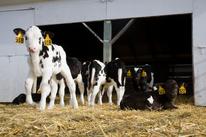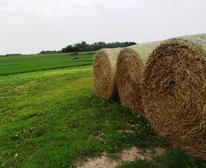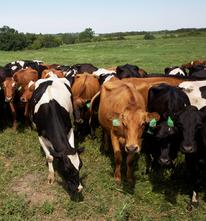By Gigi DiGiacomo
Edited by Kristine Moncada, Nicole Tautges and Craig Sheaffer
Nate and Angie Walter began transitioning their 240-acre farm and 100-cow milking herd to organic management two years ago. The Walters grazed their animals outside year-round and raised an additional two-thirds of needed supplemental feed. However, during the third and final year of the transition period, organic feed prices skyrocketed. The Walters’ calculations showed that feed costs would soon exceed revenues, and cash flow into the farm would be negative. The Walters needed to decide whether to reduce their herd size or give up on organic certification altogether.
Nate and Angie Walter began transitioning their 240-acre farm and 100-cow milking herd to organic management two years ago. Prior to transition, the Walters “were always doing 85% of the organic work and just not getting paid for it,” says Angie. “We weren’t typical conventional farmers before transition.”
Nate grew up on the dairy farm that he and Angie now manage. Nate and Angie purchased the Walter family farm in 2002 at full market value from Nate’s father: 160 acres of pasture/cropland, 80 cows, 80 young stock, equipment, and buildings. They gradually added another 20 cows and 80 acres of land. All purchases were financed with a long-term “Farm Ownership Loan” guaranteed by the Farm Service Agency (FSA).
After researching organic production for several years, Nate and Angie decided to transition their farm in October 2010. “We decided to switch after meeting with our Farm Business Management instructor,” recalls Nate. “He showed us numbers and said that the farm would have grossed another $180,000 [in 2009] if we’d been organic.” The Walters began transitioning their land in spring 2011 and their cows in the fall of 2012 so that their land and animals could be certified together in October 2013.
The Walters raised all of their own replacements (two-year-old female cows raised on the farm from birth to replace older, non-productive milk cows). They developed their own three-way cross of Norwegian Red-Guernsey-Red Holstein cows to achieve genetics that they believe are better suited to organic management (e.g., good at converting grass to milk and living year round outside).
Nate grew the feed, managed pastures, and performed the milking, while Angie handled calf feeding and helped out with other chores. The Walters ran a six-year rotation that included two years of corn and four years of alfalfa hay. Their management strategy was to raise all forage and the majority of needed grain on the farm for their 100-cow herd.
The Walters fed all the corn that they produced, supplying approximately 60 percent of the herd’s energy ration. They had to purchase additional needed grain and straw. This meant that while transitioning the herd, the Walters would have to buy 40% of their organic feed for the dairy herd at premium prices while selling their milk at conventional prices.
Uncertainty and Volatility in the Organic Market
The Walters anticipated that they would need to purchase 3,000 bushels of certified organic corn, 2,000 bushels of organic field peas/barley to supplement the feed they raised on the farm. In addition, the Walters planned to purchase 200 bales of certified organic straw.
Nate says they were “nervous” about having to buy organic feed during transition, echoing the concerns of many transitioning farmers. “We [got] a slight transition premium for milk [from Organic Valley] during our third year [of transition] but it [wasn’t] enough to compensate for the [higher organic] feed prices.” The Walters found they couldn’t afford to purchase the needed organic feed and straw. At 2012 prices, the Walters estimated they’d need approximately $61,000 to purchase the required organic feed and bedding.
The Walter’s cash flow crunch wasn’t the result of poor planning. Organic grain prices are considered very volatile due to relatively low trading volumes and lack of price transparency (publicly reported prices). When the Walters began transition, organic corn prices were $7.04/bu, according to Farm Business Management (FBM) annual financial reports. By the time they were ready to transition the herd, organic corn prices had jumped 98 percent to $13.91/bu while conventional milk prices had only grown by 19 percent from $16.27/cwt to $19.42/cwt.
The Walters were being squeezed; their projected cash flow was negative (they wouldn’t have enough income to cover their expenses). They knew that the dairy enterprise would turn a good profit once they became certified organic. Net returns per cow (profit) on conventionally-managed Minnesota dairy farms averaged $342.35 in 2010-2012. By comparison, net returns per cow on organically managed Minnesota dairy farms averaged $669.36 (after accounting for higher feed costs). The Walters idea of going organic was a good one, however, they weren’t sure they could financially survive the transition.
As a solution, the Walters considered a short-term operating loan to help pay for feed expenses but were hesitant to take on more debt (in addition to their existing term-debt acquired when purchasing the farm). They prepared a business plan and ran some numbers. Initial calculations suggested that they wouldn’t be able to cover any additional debt payments at conventional lending rates, again due to cash flow constraints. They had to choose between continued organic management and additional debt, and abandoning their dreams of organic farming. What should the Walters do?
Access the complete decision case with all educational materials (pdf) >>>
You may cite this publication as:
DiGiacomo, G. 2017. Cash Flow Crunch. A Decision Case Study in Principles for Transitioning to Organic Farming: e-Learning Materials and Decision Case Studies for Educators. K. Moncada, C. Sheaffer, and N. Tautges (Eds). University of Minnesota, St. Paul, MN.


